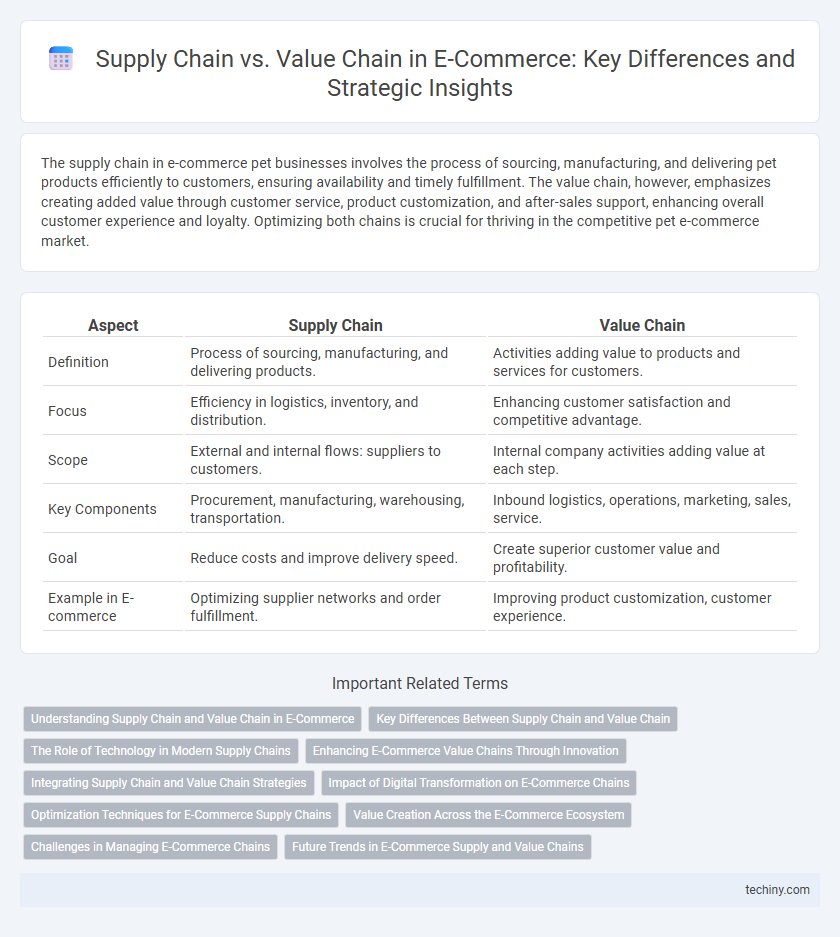The supply chain in e-commerce pet businesses involves the process of sourcing, manufacturing, and delivering pet products efficiently to customers, ensuring availability and timely fulfillment. The value chain, however, emphasizes creating added value through customer service, product customization, and after-sales support, enhancing overall customer experience and loyalty. Optimizing both chains is crucial for thriving in the competitive pet e-commerce market.
Table of Comparison
| Aspect | Supply Chain | Value Chain |
|---|---|---|
| Definition | Process of sourcing, manufacturing, and delivering products. | Activities adding value to products and services for customers. |
| Focus | Efficiency in logistics, inventory, and distribution. | Enhancing customer satisfaction and competitive advantage. |
| Scope | External and internal flows: suppliers to customers. | Internal company activities adding value at each step. |
| Key Components | Procurement, manufacturing, warehousing, transportation. | Inbound logistics, operations, marketing, sales, service. |
| Goal | Reduce costs and improve delivery speed. | Create superior customer value and profitability. |
| Example in E-commerce | Optimizing supplier networks and order fulfillment. | Improving product customization, customer experience. |
Understanding Supply Chain and Value Chain in E-Commerce
Understanding supply chain in e-commerce involves managing the flow of goods, information, and finances from suppliers to customers, ensuring timely delivery and inventory optimization. The value chain focuses on enhancing customer experience and competitive advantage by integrating activities like product development, marketing, and after-sales services. Optimizing both supply chain and value chain processes is crucial for e-commerce businesses to reduce costs and increase customer satisfaction.
Key Differences Between Supply Chain and Value Chain
The supply chain in e-commerce primarily focuses on the logistical flow of goods from suppliers to customers, emphasizing efficiency in production, inventory management, and distribution. The value chain extends beyond logistics to include activities that create value for customers, such as product development, marketing, and customer service, aiming to enhance overall customer experience and competitive advantage. Key differences lie in the supply chain's operational focus on cost reduction and delivery speed, while the value chain centers on value creation through innovation and customer engagement.
The Role of Technology in Modern Supply Chains
Technology revolutionizes modern supply chains by enabling real-time data tracking, automation, and predictive analytics, which optimize inventory management and demand forecasting. Integration of IoT devices and AI-driven platforms enhances transparency and accelerates decision-making processes, reducing operational costs and delivery times. These advancements differentiate supply chains from value chains by focusing on efficient resource flow and logistical execution rather than broader value creation activities.
Enhancing E-Commerce Value Chains Through Innovation
Innovating supply chain technologies such as AI-driven inventory management and blockchain traceability enhances e-commerce value chains by improving transparency, reducing lead times, and optimizing order fulfillment. Integration of real-time data analytics facilitates adaptive demand forecasting, enabling personalized customer experiences and reducing operational costs. These advancements drive competitive advantage by aligning supply chain efficiency with customer-centric value creation.
Integrating Supply Chain and Value Chain Strategies
Integrating supply chain and value chain strategies in e-commerce enhances operational efficiency and customer satisfaction by aligning procurement, production, and distribution with value creation and customer experience. This approach optimizes inventory management, reduces lead times, and leverages data analytics to personalize offerings, driving competitive advantage and higher profit margins. Seamless integration supports agile responsiveness to market trends, ensuring both cost-effectiveness and superior product delivery.
Impact of Digital Transformation on E-Commerce Chains
Digital transformation reshapes e-commerce supply chains by integrating advanced technologies like AI, IoT, and blockchain, enabling real-time inventory tracking and automated logistics management. Enhanced data analytics optimizes demand forecasting and personalized customer experiences, driving efficiency across the value chain from procurement to delivery. Seamless digital connectivity improves collaboration between suppliers, manufacturers, and retailers, significantly reducing lead times and operational costs while boosting customer satisfaction.
Optimization Techniques for E-Commerce Supply Chains
Optimizing e-commerce supply chains involves leveraging advanced techniques such as demand forecasting, real-time inventory tracking, and automation in order fulfillment to enhance efficiency and reduce costs. Integrating data analytics and machine learning enables dynamic route planning and predictive maintenance, minimizing delays and disruptions throughout the supply chain. Emphasizing collaboration with suppliers and third-party logistics providers further streamlines operations, improving overall responsiveness and customer satisfaction within the value chain framework.
Value Creation Across the E-Commerce Ecosystem
Value creation across the e-commerce ecosystem hinges on the integration of the value chain, which encompasses product development, marketing, customer engagement, and post-sale services, rather than solely on the supply chain processes like sourcing and logistics. Optimizing the value chain allows e-commerce businesses to enhance customer experiences, tailor offerings through data analytics, and foster brand loyalty, driving higher lifetime value and competitive advantage. Effective collaboration among suppliers, technology platforms, and service providers within the value chain is crucial to deliver seamless, personalized shopping experiences that exceed consumer expectations.
Challenges in Managing E-Commerce Chains
Managing e-commerce supply chains faces challenges like fluctuating demand forecasts, inventory inaccuracies, and complex logistics coordination across multiple distribution channels. Value chain management in e-commerce must address customer experience optimization, seamless integration of digital platforms, and real-time data analytics to enhance service delivery. Balancing cost efficiency with agility and responsiveness remains critical for competitive advantage in dynamic online retail environments.
Future Trends in E-Commerce Supply and Value Chains
Future trends in e-commerce supply chains emphasize automation, AI-driven demand forecasting, and blockchain for enhanced transparency and security. Value chains are increasingly integrating personalized customer experiences through data analytics, augmented reality, and seamless omnichannel strategies. Sustainability practices, such as circular supply chains and ethical sourcing, are becoming pivotal to both supply and value chains, driving competitive advantage and customer loyalty.
Supply Chain vs Value Chain Infographic

 techiny.com
techiny.com